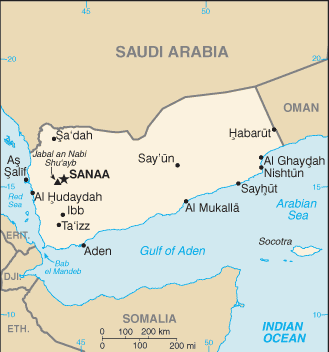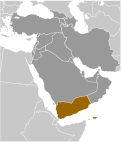
|
|
Advertisements:
People And SocietyNationality
Noun Yemeni(s)
Adjective Yemeni Ethnic groups
Predominantly Arab; but also Afro-Arab, South Asians, Europeans Languages
Arabic (official)
Religions
Muslim (Islam - official) including Shaf'i (Sunni) and Zaydi (Shia), small numbers of Jewish, Christian, and Hindu Population World Ranking: 47
24,771,809 (July 2012 est.)
Age structure
0-14 years
43% (male 5,285,218/female 5,094,736) 15-64 years 54.4% (male 6,666,600/female 6,459,414) 65 years and over 2.6% (male 298,175/female 329,349) (2011 est.) Median age
Total 18.3 years
Male 18.3 years Female 18.4 years (2012 est.) Population growth rate World Ranking: 26
2.575% (2012 est.)
Birth rate World Ranking: 33
32.57 births/1,000 population (2012 est.) Death rate World Ranking: 139
6.82 deaths/1,000 population (July 2012 est.) Net migration rate World Ranking: 73
0 migrant(s)/1,000 population (2012 est.) Urbanization
Urban population 32% of total population (2010)
Rate of urbanization 4.6% annual rate of change (2010-15 est.) Major cities - population
SANAA (capital) 2.229 million (2009) Sex ratio
At birth 1.05 male(s)/female
Under 15 years 1.04 male(s)/female 15-64 years 1.03 male(s)/female 65 years and over 0.9 male(s)/female Total population 1.03 male(s)/female (2011 est.) Maternal mortality rate World Ranking: 56
200 deaths/100,000 live births (2010) Infant mortality rate World Ranking: 39
Total 53.5 deaths/1,000 live births
Male 57.99 deaths/1,000 live births Female 48.78 deaths/1,000 live births (2012 est.) Life expectancy at birth World Ranking: 171
Total population 64.11 years
Male 62.05 years Female 66.27 years (2012 est.) Total fertility rate World Ranking: 32
4.45 children born/woman (2012 est.) Health expenditures World Ranking: 123
5.6% of GDP (2009)
Physicians density
0.3 physicians/1,000 population (2009) Hospital bed density
0.7 beds/1,000 population (2009) Hiv/aids - adult prevalence rate World Ranking: 162
0.1% (2001 est.)
Hiv/aids - people living with hiv/aids World Ranking: 92
12,000 (2001 est.)
Hiv/aids - deaths
NA
Major infectious diseases
Degree of risk High
Food or waterborne diseases Bacterial diarrhea, hepatitis A, and typhoid fever Vectorborne diseases Dengue fever and malariaWater contact disease Schistosomiasis (2009) Children under the age of 5 years underweight World Ranking: 2
43.1% (2003)
Education expenditures World Ranking: 53
5.2% of GDP (2008)
Literacy
Definition
Age 15 and over can read and write Total population 63.9%Male 81.2% Female 46.8% (2010 est.) School life expectancy (primary to tertiary education)
Total 9 years
Male 11 years Female 7 years (2005)
Comments
Add a new comment: |
Advertisement
Members area
Yemen (Sanaa):
 
GPS points from Yemen (Sanaa)
|
||||||||

 North Yemen became independent of the Ottoman Empire in 1918. The British, who had set up a protectorate area around the southern port of Aden in the 19th century, withdrew in 1967 from what became South Yemen. Three years later, the southern government adopted a Marxist orientation. The massive exodus of hundreds of thousands of Yemenis from the south to the north contributed to two decades of hostility between the states. The two countries were formally unified as the Republic of Yemen in 1990. A southern secessionist movement in 1994 was quickly subdued. In 2000, Saudi Arabia and Yemen agreed to a delimitation of their border. Fighting in the northwest between the government and Huthi rebels, a group seeking a return to traditional Zaydi Islam, began in 2004 and has since resulted in six rounds of fighting - the last ended in early 2010 with a ceasefire that continues to hold. The southern secessionist movement was revitalized in 2008 when a popular socioeconomic protest movement initiated the prior year took on political goals including secession. Public rallies in Sana'a against President SALIH - inspired by similar demonstrations in Tunisia and Egypt - slowly built momentum starting in late January 2011 fueled by complaints over high unemployment, poor economic conditions, and corruption. By the following month, some protests had resulted in violence, and the demonstrations had spread to other major cities. By March the opposition had hardened its demands and was unifying behind calls for SALIH's immediate ouster. The Gulf Cooperation Council (GCC) in late April 2011, in an attempt to mediate the crisis in Yemen, proposed an agreement in which the president would step down in exchange for immunity from prosecution. SALIH's refusal to sign an agreement led to heavy street fighting and his injury in an explosion in June 2011. The UN Security Council passed Resolution 2014 in October 2011 calling on both sides to end the violence and complete a power transfer deal. In late November 2011, President SALIH signed the GCC-brokered agreement to step down and to transfer some of his powers to Vice President Abd al-Rabuh Mansur HADI. Following elections in February 2012, won by HADI, SALIH formally transferred his powers.
North Yemen became independent of the Ottoman Empire in 1918. The British, who had set up a protectorate area around the southern port of Aden in the 19th century, withdrew in 1967 from what became South Yemen. Three years later, the southern government adopted a Marxist orientation. The massive exodus of hundreds of thousands of Yemenis from the south to the north contributed to two decades of hostility between the states. The two countries were formally unified as the Republic of Yemen in 1990. A southern secessionist movement in 1994 was quickly subdued. In 2000, Saudi Arabia and Yemen agreed to a delimitation of their border. Fighting in the northwest between the government and Huthi rebels, a group seeking a return to traditional Zaydi Islam, began in 2004 and has since resulted in six rounds of fighting - the last ended in early 2010 with a ceasefire that continues to hold. The southern secessionist movement was revitalized in 2008 when a popular socioeconomic protest movement initiated the prior year took on political goals including secession. Public rallies in Sana'a against President SALIH - inspired by similar demonstrations in Tunisia and Egypt - slowly built momentum starting in late January 2011 fueled by complaints over high unemployment, poor economic conditions, and corruption. By the following month, some protests had resulted in violence, and the demonstrations had spread to other major cities. By March the opposition had hardened its demands and was unifying behind calls for SALIH's immediate ouster. The Gulf Cooperation Council (GCC) in late April 2011, in an attempt to mediate the crisis in Yemen, proposed an agreement in which the president would step down in exchange for immunity from prosecution. SALIH's refusal to sign an agreement led to heavy street fighting and his injury in an explosion in June 2011. The UN Security Council passed Resolution 2014 in October 2011 calling on both sides to end the violence and complete a power transfer deal. In late November 2011, President SALIH signed the GCC-brokered agreement to step down and to transfer some of his powers to Vice President Abd al-Rabuh Mansur HADI. Following elections in February 2012, won by HADI, SALIH formally transferred his powers.